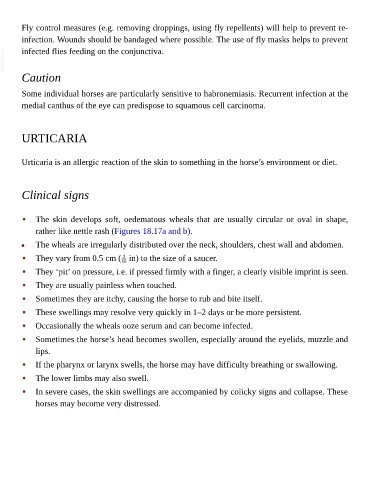Page 853 - The Veterinary Care of the Horse
P. 853
Fly control measures (e.g. removing droppings, using fly repellents) will help to prevent re-
infection. Wounds should be bandaged where possible. The use of fly masks helps to prevent
VetBooks.ir infected flies feeding on the conjunctiva.
Caution
Some individual horses are particularly sensitive to habronemiasis. Recurrent infection at the
medial canthus of the eye can predispose to squamous cell carcinoma.
URTICARIA
Urticaria is an allergic reaction of the skin to something in the horse’s environment or diet.
Clinical signs
• The skin develops soft, oedematous wheals that are usually circular or oval in shape,
rather like nettle rash (Figures 18.17a and b).
• The wheals are irregularly distributed over the neck, shoulders, chest wall and abdomen.
• They vary from 0.5 cm ( in) to the size of a saucer.
• They ‘pit’ on pressure, i.e. if pressed firmly with a finger, a clearly visible imprint is seen.
• They are usually painless when touched.
• Sometimes they are itchy, causing the horse to rub and bite itself.
• These swellings may resolve very quickly in 1–2 days or be more persistent.
• Occasionally the wheals ooze serum and can become infected.
• Sometimes the horse’s head becomes swollen, especially around the eyelids, muzzle and
lips.
• If the pharynx or larynx swells, the horse may have difficulty breathing or swallowing.
• The lower limbs may also swell.
• In severe cases, the skin swellings are accompanied by colicky signs and collapse. These
horses may become very distressed.

